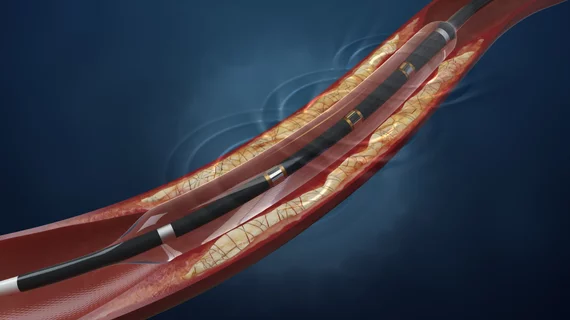Coronary IVL now recommended at all cath labs, even those without surgical backup
When the Society for Cardiovascular Angiography and Interventions (SCAI) issued a new guidance document focused on the safety of percutaneous coronary intervention (PCI), noting that it is now perfectly safe to perform at facilities without on-site surgical backup, the group also made a change that could expand the utilization of coronary intravascular lithotripsy (IVL) throughout the United States. [1]
The previous SCAI guidelines from 2014, recommended that interventional cardiologists treat high-risk patients with severely calcified lesions at facilities with surgical backup. This way, in theory, a surgical procedure could be performed much more quickly if a significant complication occurred. The new guidelines, however, emphasized the patient outcomes at facilities without on-site surgical backup have consistently been just as strong as outcomes from facilities with on-site surgical backup.
Shockwave Medical, the healthcare technology company that first developed IVL in 2009, praised the new SCAI recommendations for adapting to trends in patient care.
“With the interventional field rapidly evolving, we commend SCAI for continuously evaluating current interventional practices to ensure that their consensus documents accurately provide the best possible guidance for optimal patient care,” Doug Godshall, Shockwave Medical CEO, said in a prepared statement. “We look forward to working with sites that have not yet adopted coronary IVL due to their lack of surgical backup and to expanding the number of centers that have access to our technology due to this new guidance.”
“When a lesion is more heavily calcified than is readily apparent on angiography, it is critical to have a strategy to safely and immediately modify the calcium to be able to successfully proceed with the case,” added Clay Sizemore, MD, a cardiologist with Cardiovascular Consultants of South Georgia who has experience with coronary IVL. “The previous guidelines required these patients in facilities without surgical backup be transferred interprocedurally via an ambulance to a cath lab with on-site surgical backup. Not only were these transfers sub-optimal for the patient, but they consumed resources in two hospitals as well as valuable physician time that was taken away from treating additional patients. Now, with IVL we have a tool that can safely modify severely calcified lesions, but that does not have the associated risk that requires on-site surgical backup.”
The updated SCAI guidelines, published in full in the Journal of the Society for Cardiovascular Angiography and Interventions and JACC: Cardiovascular Interventions, were endorsed by the American College of Cardiology, American Heart Association, British Cardiovascular Intervention Society, Canadian Association of Interventional Cardiologists and Outpatient Endovascular and Interventional Society.
Read more about the updated SCAI guidelines here. The full document is available here.

